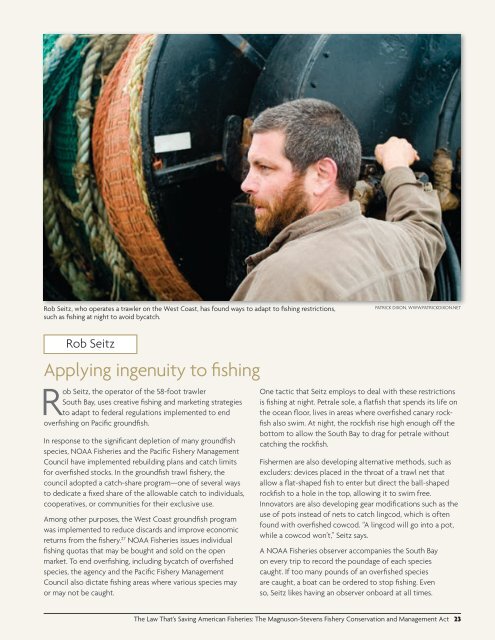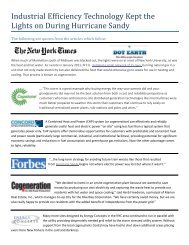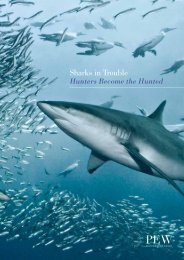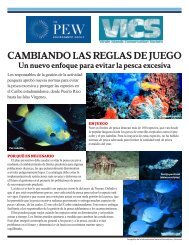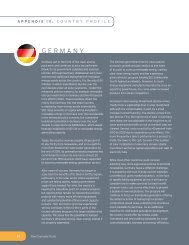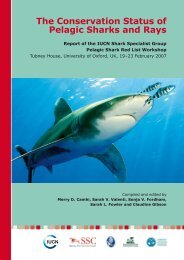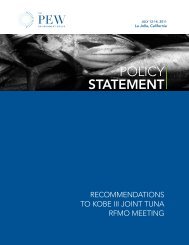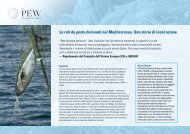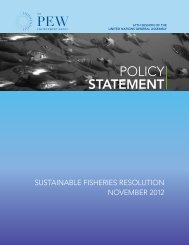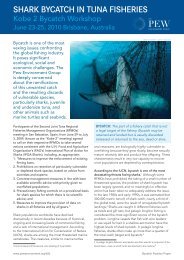The Law That's Saving American Fisheries - Ocean Conservancy
The Law That's Saving American Fisheries - Ocean Conservancy
The Law That's Saving American Fisheries - Ocean Conservancy
You also want an ePaper? Increase the reach of your titles
YUMPU automatically turns print PDFs into web optimized ePapers that Google loves.
Rob Seitz, who operates a trawler on the West Coast, has found ways to adapt to fishing restrictions,<br />
such as fishing at night to avoid bycatch.<br />
PATRICK Dixon, www.PATRICKDixon.net<br />
Rob Seitz<br />
Applying ingenuity to fishing<br />
Rob Seitz, the operator of the 58-foot trawler<br />
South Bay, uses creative fishing and marketing strategies<br />
to adapt to federal regulations implemented to end<br />
overfishing on Pacific groundfish.<br />
In response to the significant depletion of many groundfish<br />
species, NOAA <strong>Fisheries</strong> and the Pacific Fishery Management<br />
Council have implemented rebuilding plans and catch limits<br />
for overfished stocks. In the groundfish trawl fishery, the<br />
council adopted a catch-share program—one of several ways<br />
to dedicate a fixed share of the allowable catch to individuals,<br />
cooperatives, or communities for their exclusive use.<br />
Among other purposes, the West Coast groundfish program<br />
was implemented to reduce discards and improve economic<br />
returns from the fishery. 27 NOAA <strong>Fisheries</strong> issues individual<br />
fishing quotas that may be bought and sold on the open<br />
market. To end overfishing, including bycatch of overfished<br />
species, the agency and the Pacific Fishery Management<br />
Council also dictate fishing areas where various species may<br />
or may not be caught.<br />
One tactic that Seitz employs to deal with these restrictions<br />
is fishing at night. Petrale sole, a flatfish that spends its life on<br />
the ocean floor, lives in areas where overfished canary rockfish<br />
also swim. At night, the rockfish rise high enough off the<br />
bottom to allow the South Bay to drag for petrale without<br />
catching the rockfish.<br />
Fishermen are also developing alternative methods, such as<br />
excluders: devices placed in the throat of a trawl net that<br />
allow a flat-shaped fish to enter but direct the ball-shaped<br />
rockfish to a hole in the top, allowing it to swim free.<br />
Innovators are also developing gear modifications such as the<br />
use of pots instead of nets to catch lingcod, which is often<br />
found with overfished cowcod. “A lingcod will go into a pot,<br />
while a cowcod won’t,” Seitz says.<br />
A NOAA <strong>Fisheries</strong> observer accompanies the South Bay<br />
on every trip to record the poundage of each species<br />
caught. If too many pounds of an overfished species<br />
are caught, a boat can be ordered to stop fishing. Even<br />
so, Seitz likes having an observer onboard at all times.<br />
<strong>The</strong> <strong>Law</strong> That’s <strong>Saving</strong> <strong>American</strong> <strong>Fisheries</strong>: <strong>The</strong> Magnuson-Stevens Fishery Conservation and Management Act 23


